|

To begin with a comforting notion: GIPF is not hard
to learn. The length of these rules is not meant to overwhelm you.
It is a result of our attempt to be as complete as possible, so
that every player - even those unfamiliar with strategic games -
will find the answers to every possible question. Take some time
to review these rules. If you do, you will discover a pure and challenging
game, offering plenty of variation and inexhaustible possibilities.
Contents
One game board, 18 white basic pieces, 18 black basic pieces, and
one rule book.
The rules are separated into 3 parts:
1. Basic rules.
How to play GIPF with pieces in their elementary application.
2. Standard rules.
How to play the standard version and introducing GIPF-pieces, i.e.
2 pieces stacked one upon another.
3. Tournament rules.
The version for advanced players.
(For readability purposes, these rules use masculine pronouns when
referring to "a player". These pronouns convey he/she, him/her,
etc.)
1. BASIC RULES
A. Game board
The board shows a pattern of lines. Each line starts and ends with
a dot, and has in between these dots a number of intersections with
other lines. These intersections are called spots.
1. There are 24 dots at the edges of the pattern on the board. Dots
aren't part of the play area; they serve to position a piece before
bringing it into play.
2. The play area is made up of 37 37 spots (i.e. the central part
of the board). Only the pieces covering a spot are part of the game.
3. The lines indicate the directions in which pieces may be moved.
B. Starting the game
1. The players draw lots for their color. White begins.
2. The basic version is played with 15 pieces per player. The remaining
pieces can be used either to play a longer game.(i.e. both players
start with 1, 2 or 3 extra pieces) or to equate the strength of
the players (i.e. the less experienced player gets an advantage
of 1, 2 or 3 pieces).
The board must be placed between the players in such a way that
the dot marked "E1" points at the player with the white pieces.
The players start the game with 3 pieces each on the board. They
are to be placed on the angular dots, the colors alternating with
each other, and next moved to the first spot in the direction of
the centre. Now they are in play.
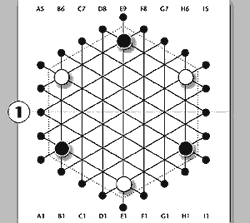 Diagram
1 Diagram
1
Starting position. Each player has 12 pieces left. Pieces which
are not in play are hereafter referred to as the reserve.
C. Goal
The aim is to capture opponent's pieces, so that eventually he has
no pieces left in his reserve (i.e. he can't play any more).
D. A turn
The players take turns. Each turn a player must add one piece to
the game and this must be done in 2 steps: one takes a piece from
his reserve and places it on any of the 24 dots (step 1) and then
moves it onto a spot in the play area (step 2).
1. First one must put a piece on a dot (step 1). A piece is not
in play as long as it is covering a dot, meaning that the turn isn't
completed.
One has two options for the second step:
- One can push a piece from a dot onto a free spot in the play area.
As soon as a piece is pushed in the direction of a spot, one cannot
change his mind anymore. The move must be made.
- One can also push a piece from a dot to a spot already occupied
by another piece. In this case, the occupied spot must first be
cleared: the piece occupying it (regardless of its color) must be
moved to the next spot on the line; if that spot is also occupied,
then this piece also moves over one spot, etc. Next, one pushes
the new piece onto the cleared spot. Note that all the pieces are
moved in one and the same direction. It is advisable not to "push"
a row of pieces; always move pieces one by one, starting with furthest
piece in the row. Once a player has touched a piece in the play
area, the move must be completed.
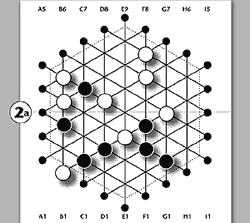 |
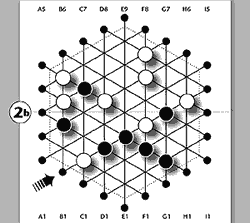 |
Diagrams
2a
White puts a piece on dot b1. This is step 1. |
Diagrams
2b
Step 2: White moves over the pieces on the b1-i4 line 1 spot.
This completes the move. |
2. One can move a piece only one spot at a
time, never two or more.
3. It is not allowed to push a piece out of the play area (i.e.onto
the dot at the opposite far end of a line).
 Diagram 3
Diagram 3
The indicated lines are blocked.
E. Taking pieces
1. As soon as 4 pieces of the same color are lined up next to each
other, they must be taken from the board by the one playing with
that color. Moreover, not only must these 4 pieces be removed, but
also all of the pieces that form a direct extension of them. The
pieces of one's own color are returned to the reserve, the pieces
of the other color are captured, thus lost for the opponent.
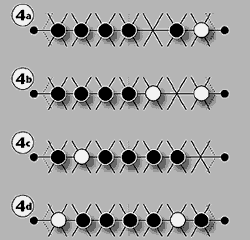 Diagrams Diagrams
4a) Black removes 4 black pieces. (Note that the free spot interrupts
the row!)
4b) Black removes 4 black pieces and 1 white.
4c) Black removes 5 black pieces and 1 white.
4d) Black removes 5 black pieces and 2 whites.
2. As soon as 4 pieces of the same color are lined up, it is compulsory
to remove them from the board (included the pieces extending the
row), no matter who created the row. The color of the pieces in
a row determines which player must take them. One's own pieces are
returned to the reserve, the opponent's pieces are captured.
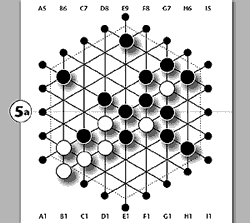 |
 |
Diagram
5a
Step 1: White puts a piece on spot b1… |
Diagram
5b
Step 2: … and forces Black to return 5 pieces to his reserve.
If a white piece would have extended the row (on spot c5), Black
would have captured it. |
3. It may occur that two rows are lined up
at the same time. If these rows don't intersect, both must be captured;
if they do intersect, the player playing with that color may choose
which row he will take.
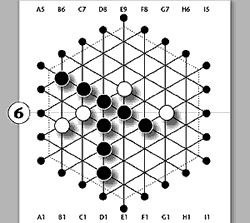 Diagram
6: Diagram
6:
Black may choose between taking the row with 4 pieces or the one
with 5 pieces. After having removed one row, the other isn't complete
any more. The remaining pieces must be left on the board.
4. When a situation occurs in which both players must take pieces,
the player who caused the situation goes first.
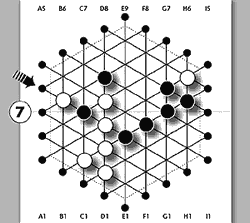 Diagram
7 Diagram
7
White has made the move indicated by the arrow and may take pieces
first. He takes 4 white pieces and 1 black piece. Next Black must
remove his 4 black pieces and captures nothing.
(If Black would have made that move - with
a black piece, of course - he would have captured 2 white pieces.)
5. capturing pieces does not count as a turn! (See again illustrations
5a and 5b: White forces Black to take pieces; Black removes the
pieces and next has to make a move.)
F. End of the game
The game ends when one of the players cannot bring a piece into
play. Thus, if a player has no pieces left in his reserve, the other
player is the winner.
Remark 1: don't misinterpret the aim of the game; one can only win
by capturing the opponent's pieces, not by returning your own pieces
repeatedly from the board to the reserve!
Remark 2: a tie is not possible. The first player to run out of
pieces loses the game, even if the other player, too, would run
out of pieces in his next turn.
Remark 3: a player should always be able to see how many pieces
the opponent has left in his reserve. Leave them clearly visible
next to the board.
2. STANDARD RULES
This version is played according to exactly the same rules as the
basic version, but with the addition of GIPF-pieces. A GIPF-piece
consists of 2 basic pieces stacked one on top of another. A GIPF-piece
counts as "one" piece on the board. On the one hand, just as in
the basic game, a player must comply with the rule to bring a piece
into play each turn; on the other hand, he must also take care that
his "GIPF" stays in play (i.e. at least one GIPF-piece must remain
on the board).
A. Begin
Both players take 18 basic pieces. The start position remains the
same but now they start with each 3 GIPF-pieces on the board. (See
Diagram 1: GIPF-pieces instead of basic pieces.)
B. GIPF
1. The difference between a basic piece and a GIPF-piece is that
it is not obligatory to remove a GIPF-piece (neither your own, nor
your opponent's). Put in other words: when a GIPF-piece (regardless
of its color) is part of a row that must be taken from the board,
then a player is free to choose between taking it or leaving it
on its spot. In most cases the choice will amount to taking a GIPF-piece
only when it belongs to the opponent. (But be careful: situations
will certainly occur in which it may be better to deviate from this
strategy.)
 Diagram
8: White takes 3 white basic pieces and 1 black basic piece; most
likely White will also take the black GIPF-piece, but leave the
2 white GIPF-pieces on the board. Diagram
8: White takes 3 white basic pieces and 1 black basic piece; most
likely White will also take the black GIPF-piece, but leave the
2 white GIPF-pieces on the board.
2. When two rows of at least 4 pieces of the same color intersect
each other and the spot of intersection is occupied by a GIPF-piece,
then the player may choose whether he will take one or two rows
from the board. Either he captures only one row, including the GIPF-piece
on the intersection spot (which means there is no second row to
be taken any more), or he takes one row and leaves the GIPF-piece
on its spot, thus having to remove the second row as well (with
or without the GIPF-piece). 3. When a player captures a GIPF-piece
of his own color, it must be returned to the reserve as two separate
basic pieces; they may not be brought into play again as a GIPF-piece.
C. End of a game
Now there are two ways of winning: one must succeed in removing
the opponent's GIPF from the board (i.e. all of his GIPF-pieces)
or one must exhaust the opponent's reserve. Put in other words:
a player who has either lost his last GIPF-piece, or has no basic
piece left to bring into play, loses the game.
3. TOURNAMENT RULES
The standard game in itself is a complex and difficult game to master;
it offers so many possibilities that not everyone will be waiting
for even more possibilities. Without any doubt, some will prefer
the standard game (and even the basic game) above the tournament
version. Therefore we advise players to look at this variant as
nothing but an option; by no means is it meant as an obligatory
GIPF-exercise. Concerning the rules, there are only a few changes
in the beginning of the game.
1. The game starts with an empty board (i.e. there is no starting
position any more).
2. Both players are obliged to use their first turn to bring a GIPF-piece
into play. This must be done as a standard move: one places a GIPF-piece
on any of the dots and next moves it onto a spot in the play area.
3. The game is played without a fixed number of GIPF-pieces per
player. The players are completely free to also use their second,
third, fourth (et cetera) turn to bring more GIPF-pieces into play.
4. Once a player has decided for himself that he has a sufficient
number of GIPF-pieces in the play area, he may start playing with
single pieces. But, as soon as he has brings a single piece into
play, this means that he can bring no more GIPF-pieces into play
during the further development of the game. The opponent may still
do so, until he, too, plays his first single piece. (Also during
this start-up phase, the players take turns without interruption.)
The further game is played according to exactly the same rules as
the standard game, and to win a player pursues the same goals.
Remark: when playing the tournament version in may occur
that 4 (or even more) GIPF-pieces of one color are lined up. In
this case, the player playing with that color may leave them on
their spots or he may take one or more GIPF-pieces from the board,
either before or after making his move. If he should decide to leave
them on the board and they are still lined up when it is his turn
again, then he may again choose between these two options.
Enjoy the game!
|
 Diagram
1
Diagram
1

 Diagram 3
Diagram 3  Diagrams
Diagrams


 Diagram
6:
Diagram
6:  Diagram
7
Diagram
7  Diagram
8: White takes 3 white basic pieces and 1 black basic piece; most
likely White will also take the black GIPF-piece, but leave the
2 white GIPF-pieces on the board.
Diagram
8: White takes 3 white basic pieces and 1 black basic piece; most
likely White will also take the black GIPF-piece, but leave the
2 white GIPF-pieces on the board.